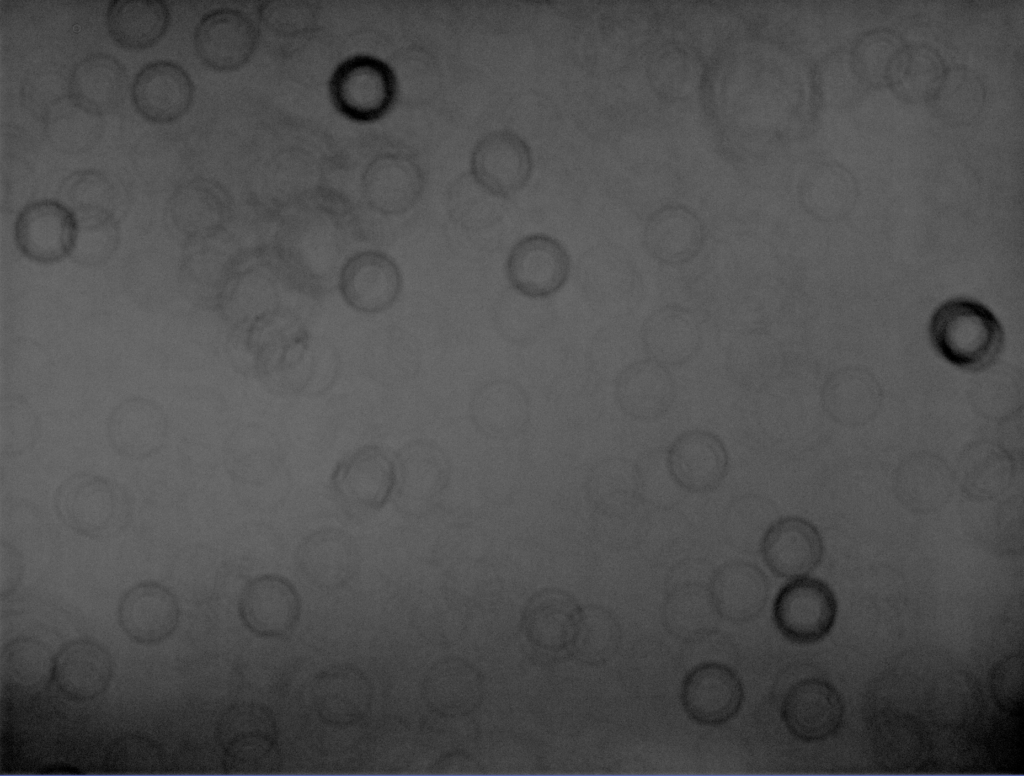21:00 – 01:00
I went out this evening and locked in on M76. I imaged in SII for 600s on the 12″
21:00 – 01:00
I went out this evening and locked in on M76. I imaged in SII for 600s on the 12″
19:01 – 03:05
Dome open on the freezing night, currently -2℃, and I have fixed the dome slipping for the 2nd time this week, this time putting new grip tape on a hole that had appeared due to the wheel slipping.
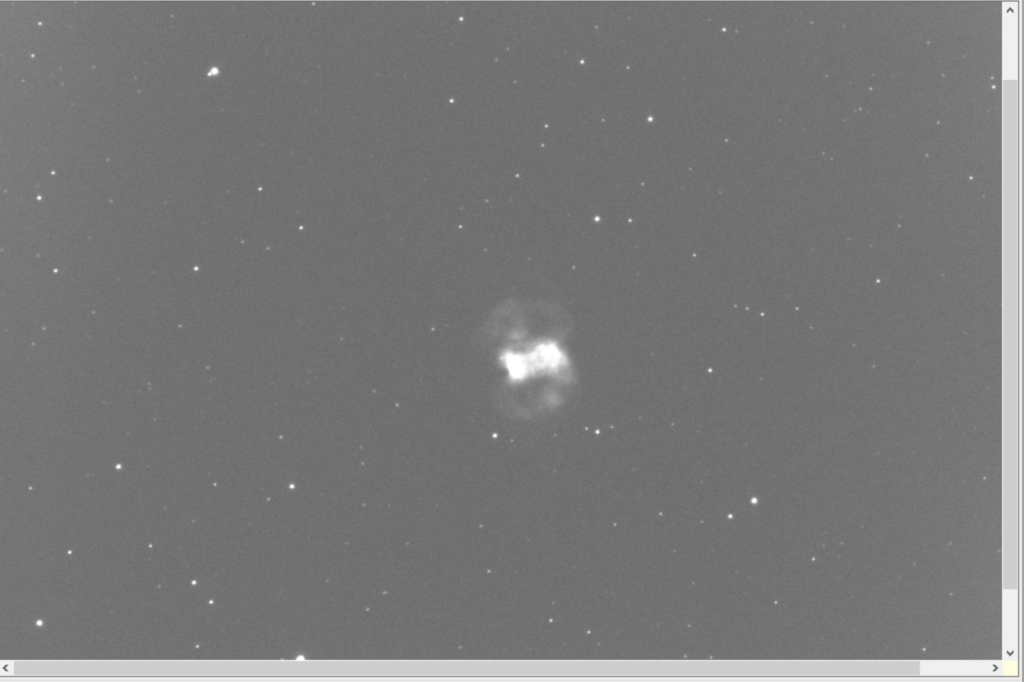
Started out imaging M76 which is near the Zenith whilst we watch Harry Potter in the warmth of the lounge buy a roaring fire. After 11 frames of 600s in OIII I have stopped and slewed through Meridian flip and now started on Ha as I have 84 frames of OIII already……
So at 1:15pm I had 23 x 600s Ha on M76. Whilst I need much more and then RGB frames, I want to go to bed and M76 will set shortly to a less than desirable altitude. So I took my flats, darks and flats darks and closed the dome up for the night as the Moon was still fairly full.
19:26 – 01:30
I started with M76 Ha as I need some frame for this object. I already have many hours in OIII. However after starting to image I realised the guiding, which is currently being tested through Dave Boddington’s ST80 was not pointing through the slit correctly as M76 was near the zenith. This means I have suffered from trailing as the guider was trying to guide on long stars due to diffraction.
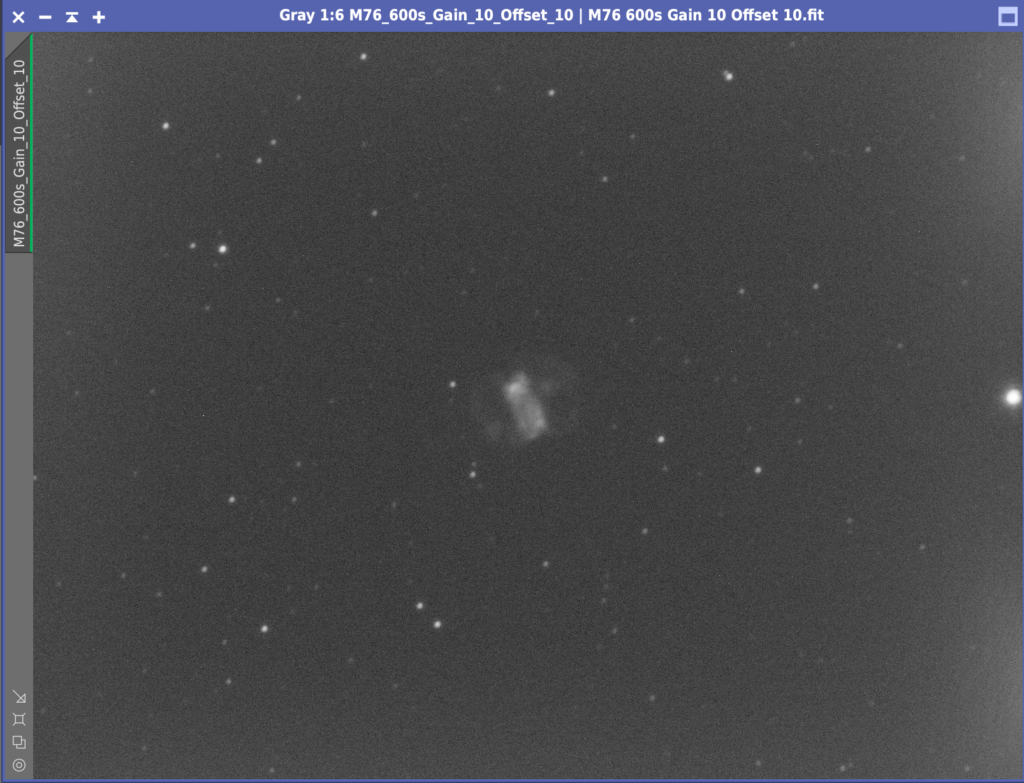
I swapped to a different object, this time M32 as I have not imaged this directly before, just as a happenstance of imaging M31. I have chosen 180s exposures using Gain 139 Offset 21 to keep the saturation of the core down. At 300s the core was blown out.
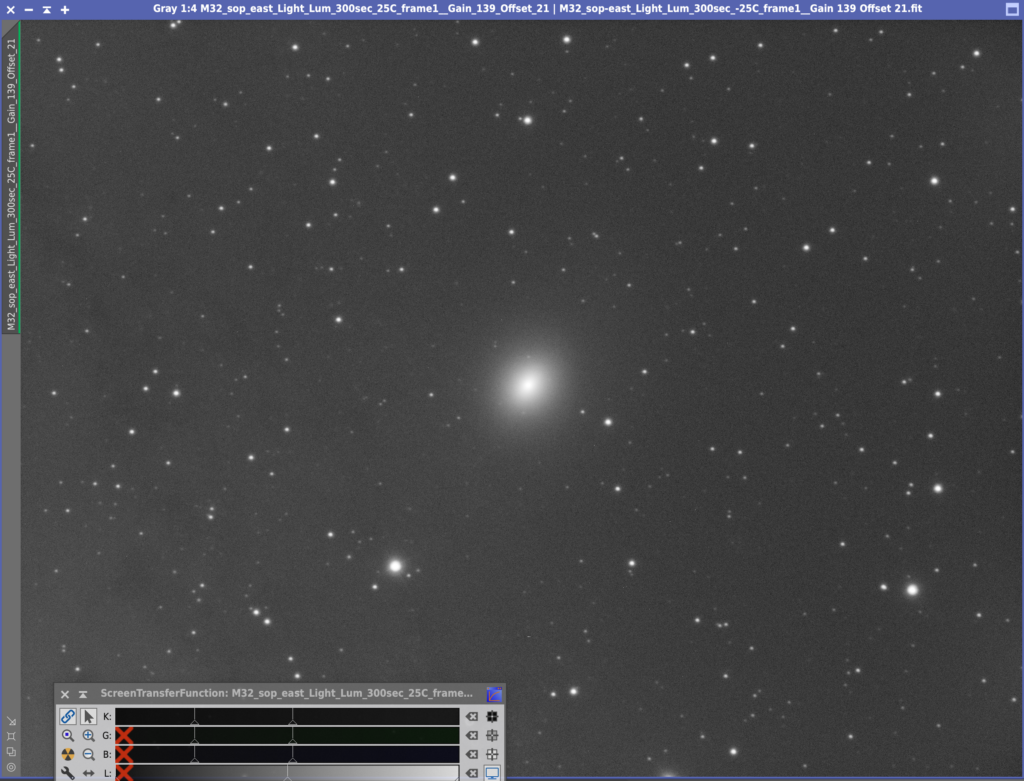
M31 can be seen to the left and lower left of the small galaxy. M31 covers a large part of this image! So how well was my guiding doing?
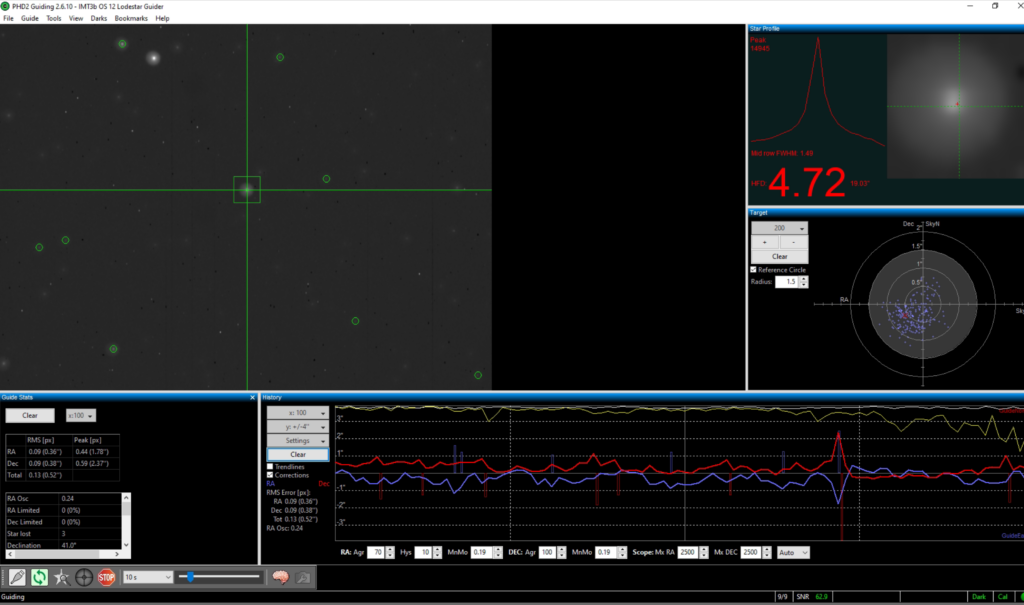
The guiding looked fine. 0.52 arcsecs total error which I am happy with. I stayed up until just before midnight and then left the observatory running. In the morning I noticed the dome shut around 1:30pm due to the images after that looking like flats.
I also noticed this morning that the images were drifting so the guiding is not quite right as the image drifts. I will next time out run the guiding assistant and see if that helps.
Update the image scrubbed up fairly well but I lost a lot of frames to drift and trailed stars and then the dome closing. Resulting image around 3 hours 12 minutes exposure of which 48 mins was Luminance but there was cloud affecting many frames.
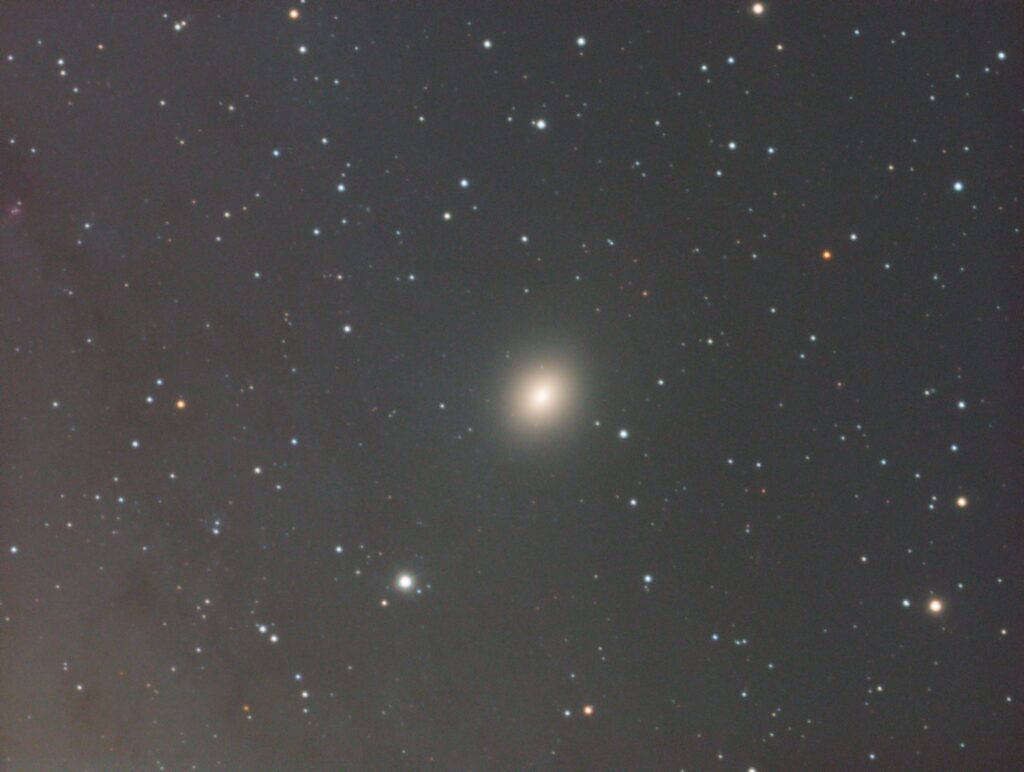
Below is a copy of the nights weather data.
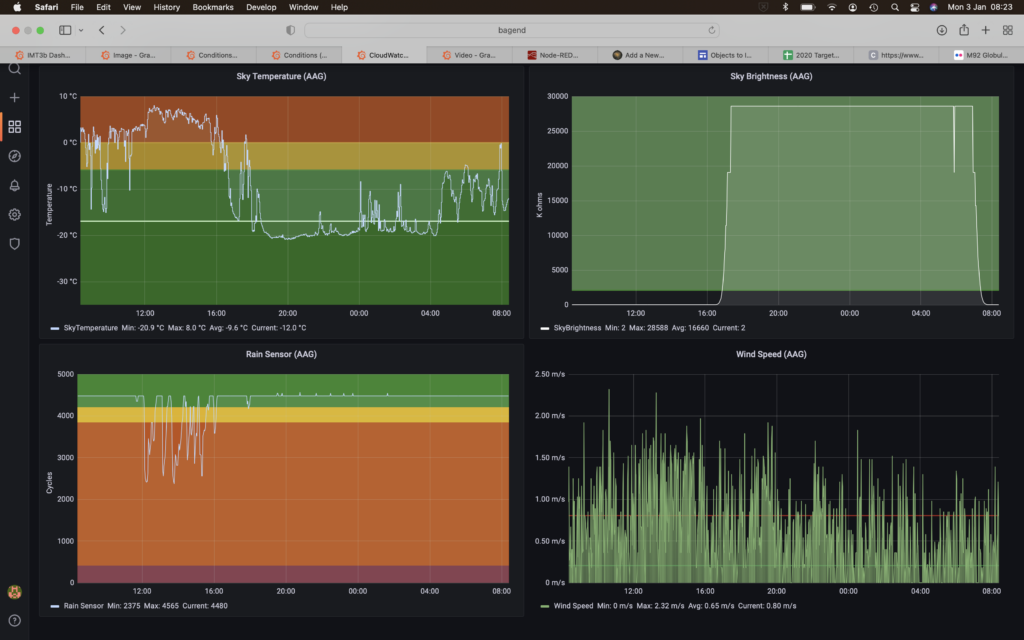
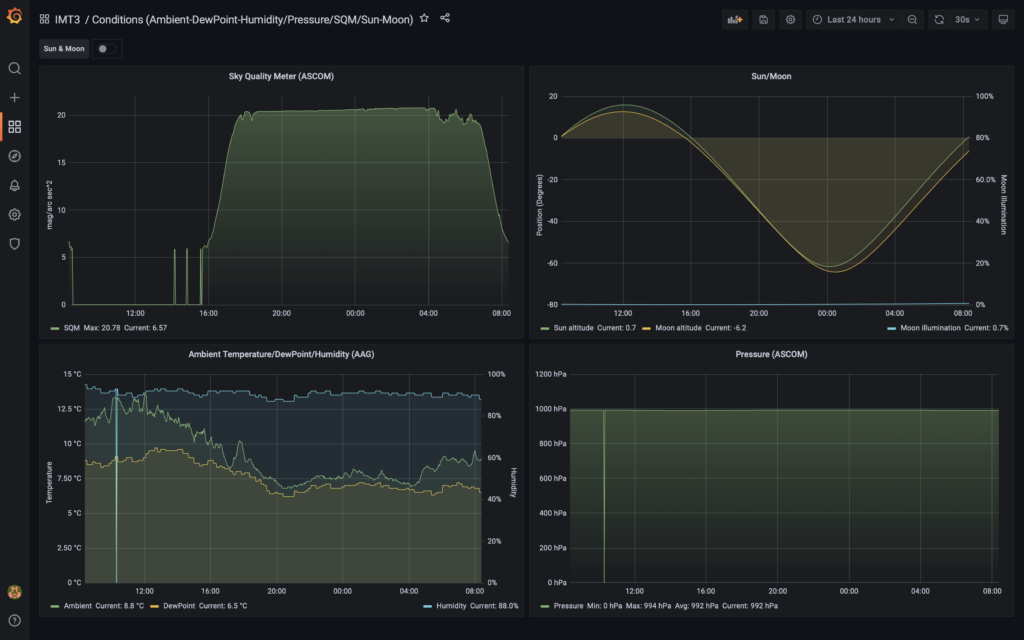
Viewing time period – 21:38 – 01:50
Quick set of images this evening to take some more data of M76. I can image for 3 hours before a meridian flip. I need to get the automated flip working and thus the plate solving that seems to be having issues. For now I will open the dome and just set it running on OIII through the 12″.
After entering with TSX connected to the ASI camera I started guiding and for setup reasons I have included the guide star here.
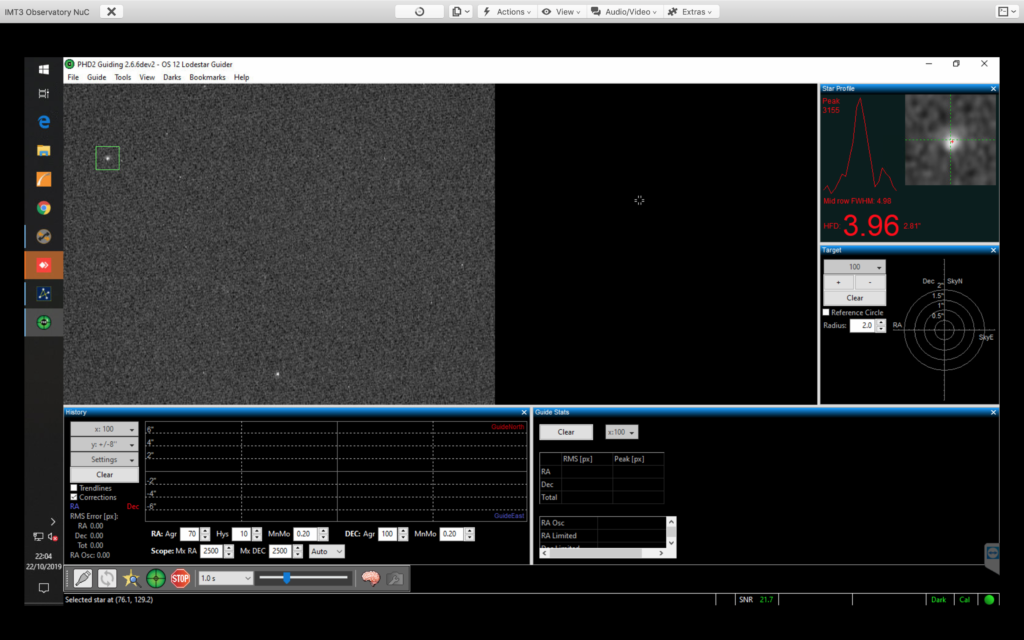
@00:45 I managed to do the manual meridian flip and then headed off to be after collecting another 2 hours of OIII data. I left the scope running for the rest of the night knowing that the dome would shut if the sky clouded up.
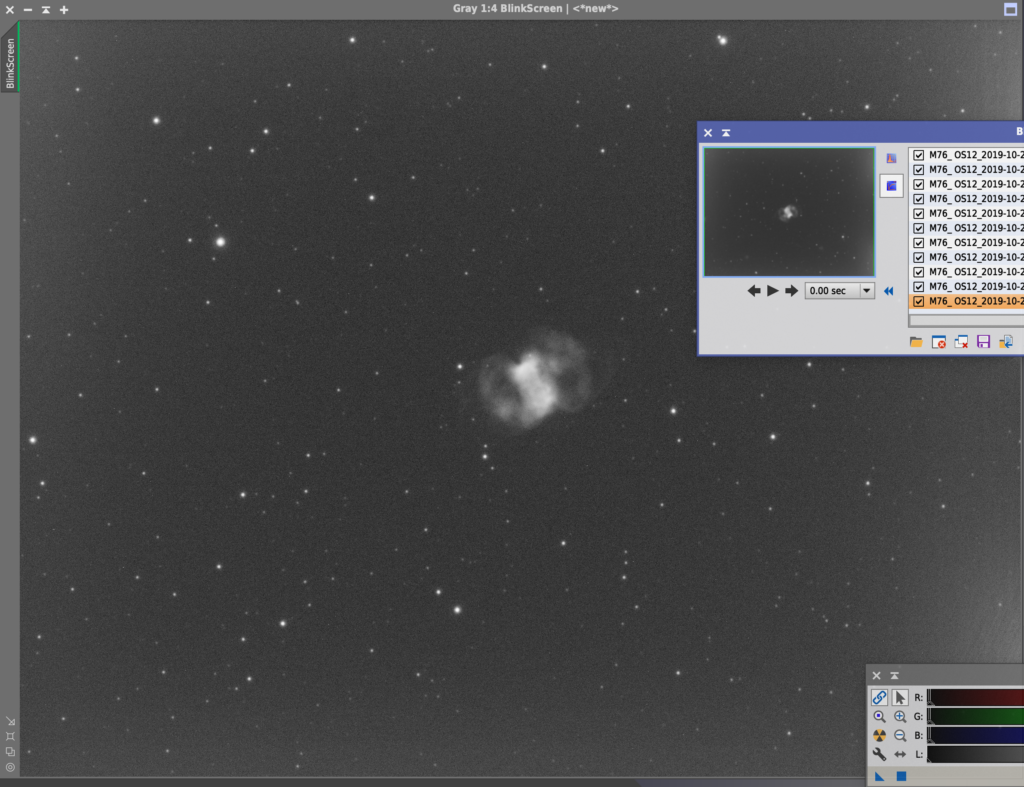
So I am now up at 7am and indeed the dome closed when the clouds rolled in. I have no real notification of when that occurred so I have now set the HitecWeather station software to log on the triggering of the relay to a file so I can see the time it closed.


This will allow me to compare to the Keogram from the ASC and double check the dome is closing at the appropriate time.
Fortunately SGPro is connected to the weather station as a safety monitor and stops imaging if the dome closes. I can see the clouds started to roll in around 1:30am for a few minutes then just before 2pm there were more and by 2:43am after they covered the sky. The good thing is it looks like, although I cannot be sure, the dome would have closed at around 1:50am which is the time of the last image taken assuming the date stamp is the completion of the image.

I have now taken flats and darks and parked the scope and it is ready for it’s next outing, I also remembered to turn the dehumidifier back on this time. Both the dehumidifier and the flat panel need connecting to an Arduino to automate turning on and off.
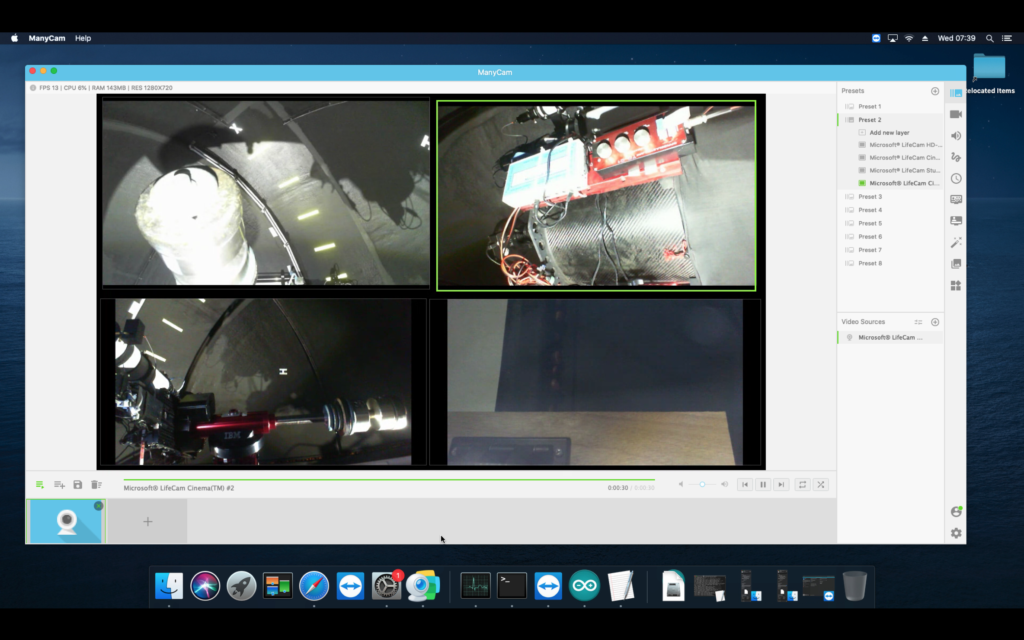
Viewing time period – 20:43 – 04:32
First thing to say is this is a very long blog, much went wrong tonight before it went right and thus I selected to record as much of the problems here as evidence later if I have the same problem or others indeed do. Tonight I am imaging M76 a planetary nebula in Perseus known as the Little Dumbbell. This is my first real object to image through the IMT3’s 12″ scope. The weather looked good and a quick look through the All Sky Camera showed a clear sky with Vega shining bright overhead and a slight glow with the Sun still setting to the West.
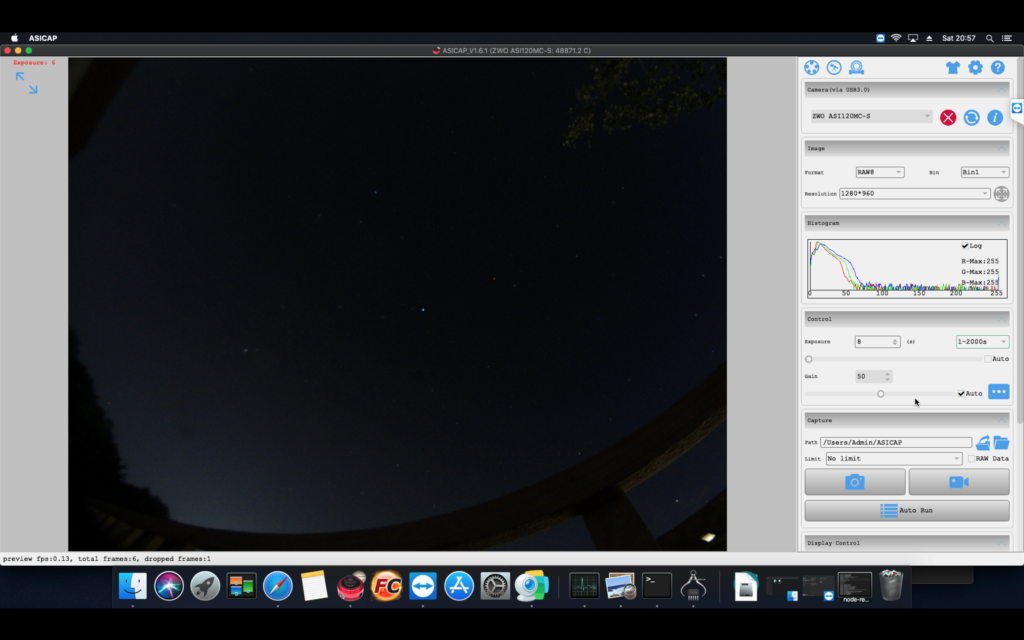
The first thing I needed to do was to slew to a bright mag +2 star, in this instance Caph in nearby Cassiopeia and centre and sync the scope which I did through TheSkyX (TSX). I then slewed to a magnitude +9 star (SAO 21164) nearby so that I could perform an autofocus through the OIII filter using SGPro. The best fit was 73,914.
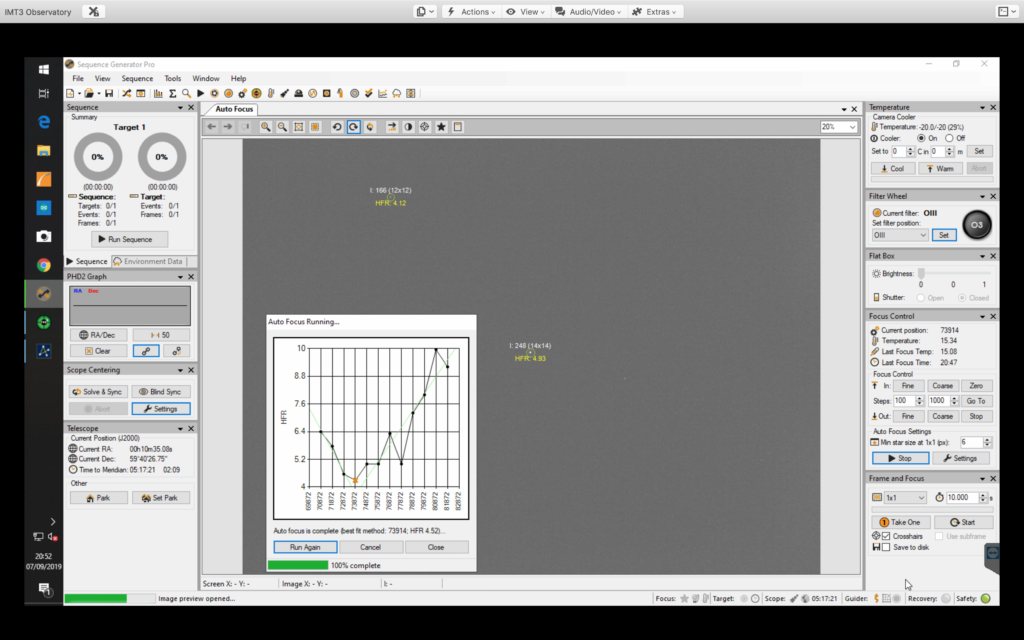
I then took a single 60s exposure just to make sure the focus was right, the stars coming in at around Half Flux Radius (HFR) 4. Meanwhile the camera cooler was running at -20℃ and 28% so I lowered to -28℃ at 60%. It should be noted that every time I perform a closed loop slew in TSX and the camera connects, the camera then looses the information of its status in SGPro and the only way to resolve to disconnect and reconnect. I again will note this is the TOSA User Guide.
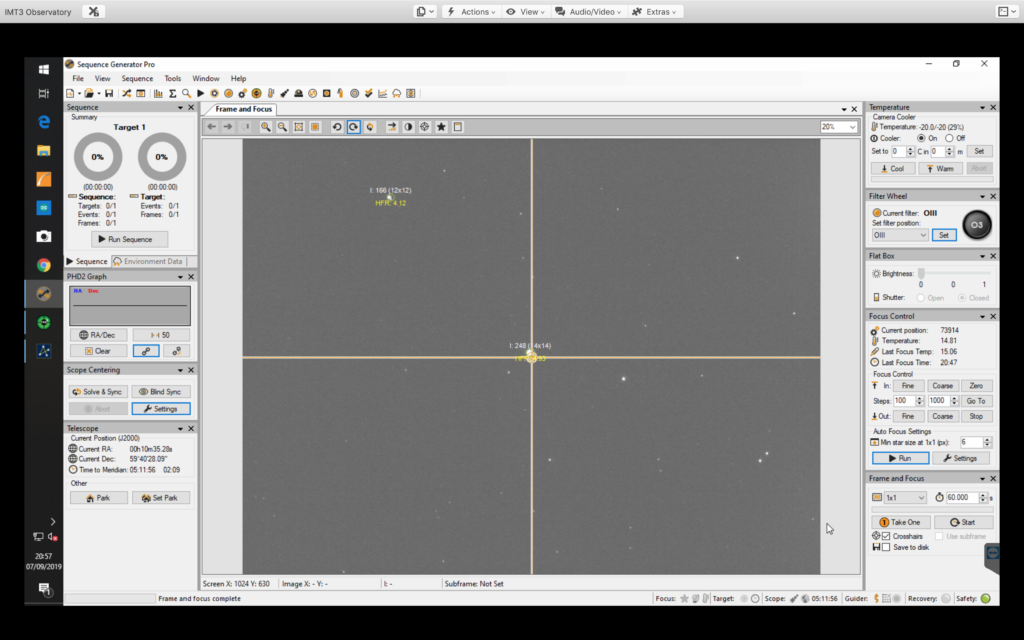
Then I slewed to M76, which on first inspection was still being my neighbours house. So I waited for a while longer and around 21:10 it appeared above the roof for its polar orbit around Polaris. I took a quick image with SGPro of 60 seconds through the OIII filer to see where I was pointing, given I only have a 60 point TPoint model (I need 300 for the best pointing accuracy).

So given I was slightly out I selected the Luminance filter, went back to TSX and performed another Closed Loop Slew and then synced the scope for good measure. The resulting image through TSX and then through SGPro showed a perfect improvement.

Before imaging I went back to look at the PEC as Bob had mentioned not being able to image for very long on the Tak FS102 after we had taken it off, added the adjuster plate, reattached and added some weights. Not surprisingly the TPoint model will need redoing, however I noted the PEC was turned off, maybe I had not saved the last time I enabled. So I reenabled and saved.
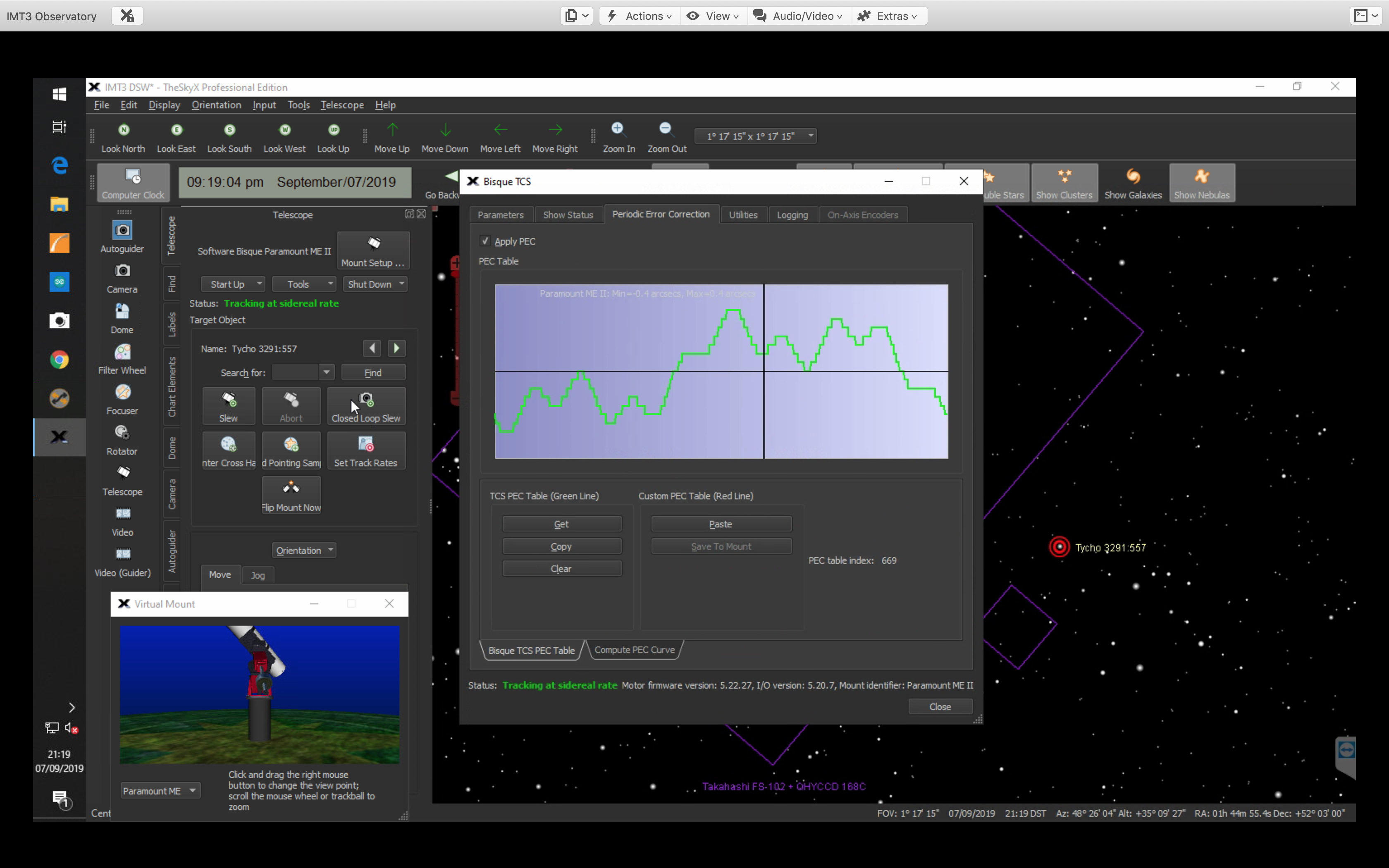
I then went looking for a guide star with PHD2, however even with 10 seconds I could not see one. I looked at TSX and indeed the Field of View (FoV) indicator for the guider showed a fairly barren piece of sky with barely a magnitude +11 star visible.
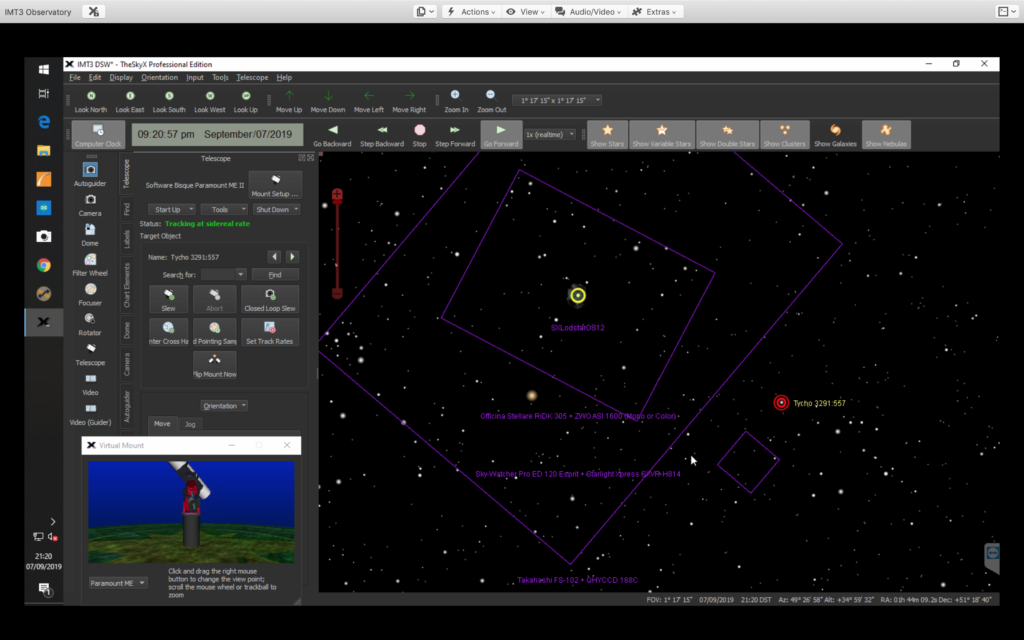
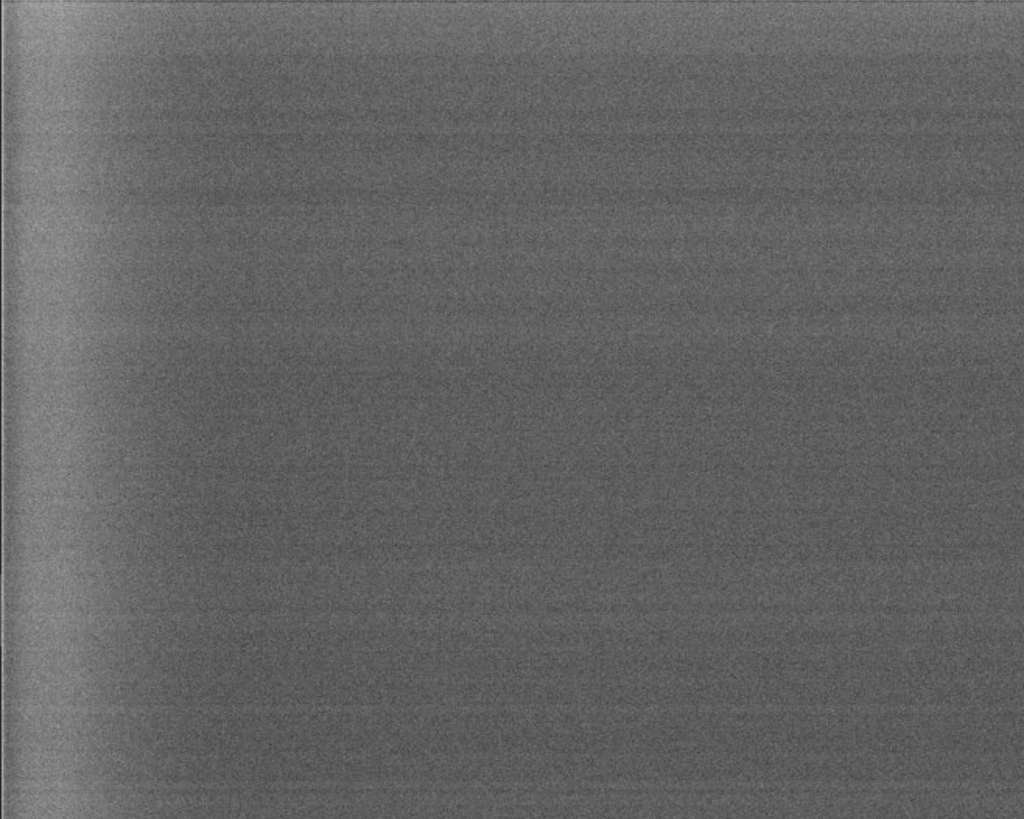
I performed a quick check of the SQM and it was reading 19.37 and the Hitec Weather station had a reading of around 25 meaning between Haze and Clear. Another quick check of the ASC and that was showing clear. So either I had to move the scope to find a guide star or I could image without guiding……so the only way to tell was take a quick 5min image and see what it looked like.
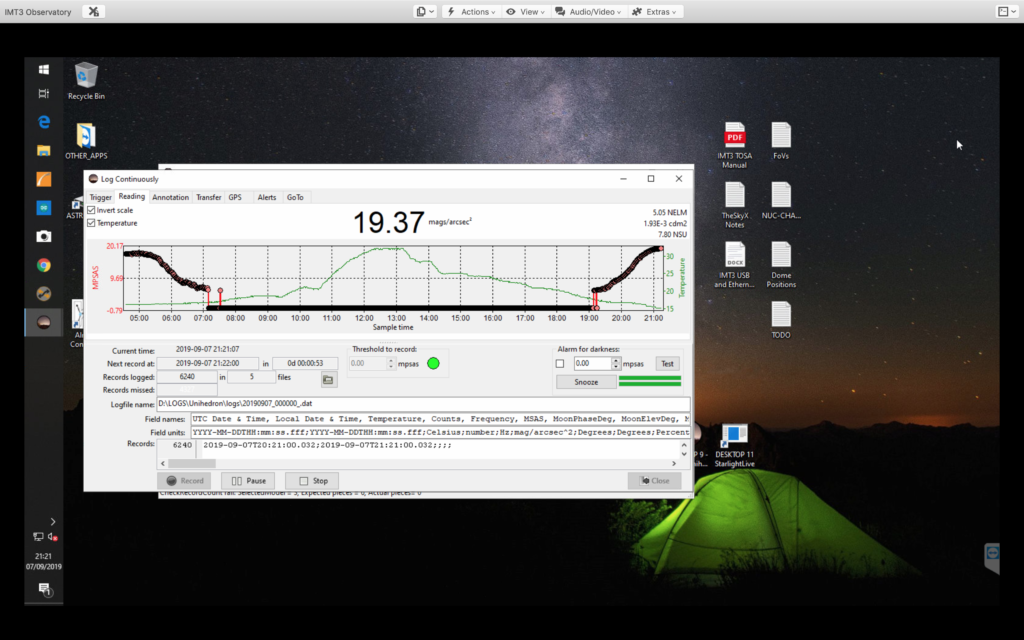
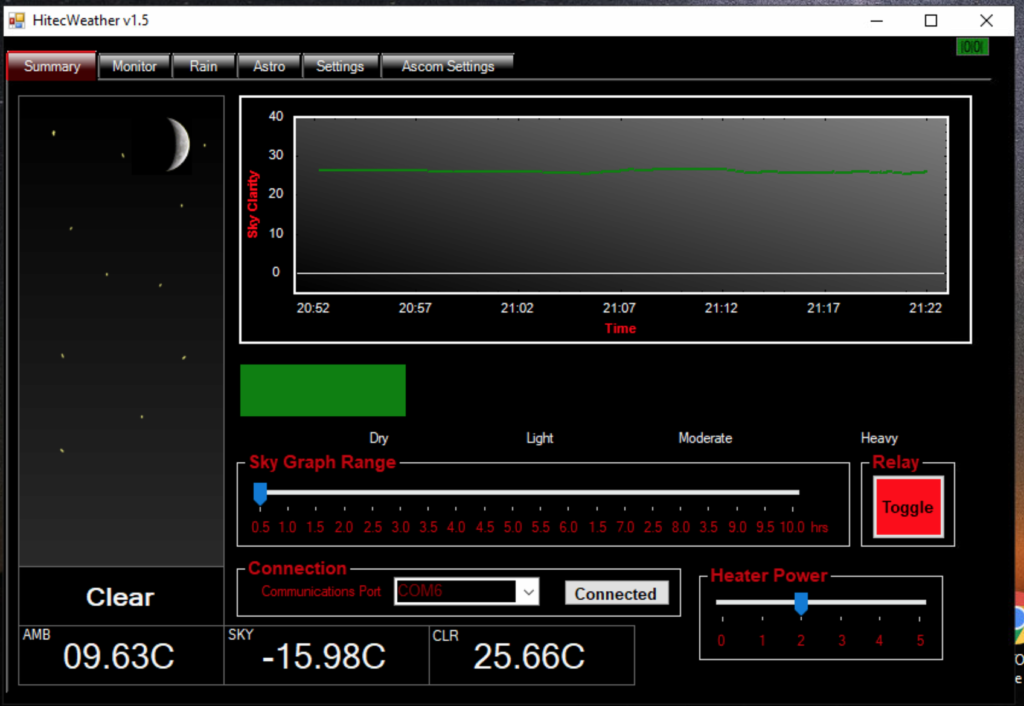
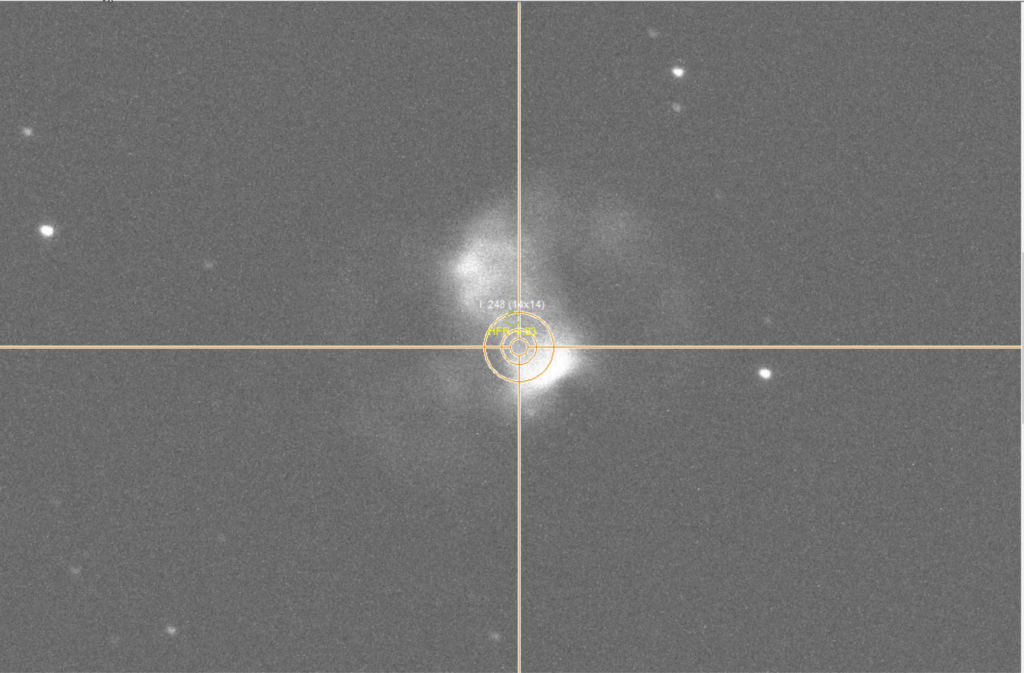
As suspected the resulting 5min image showed trailing, not surprising given the TPoint model is out so I decided to guide. I slewed around trying to find a decent guide star but nothing came up, literally nothing, which then got me thinking this was not right. So I checked a bright star in the FoV for the guider, still nothing. So I then disconnected the camera and checked the settings and there it was, the setting was for the SX814 which was not powered on (aka GingerGeeks main camera on the Epsrit 120) so I changed this to the Lodestar and took another image, this came into view! Not sure the problem of why it keeps reverting to the SX814 but I will need to check each time and will add to the TOSA User Guide.

So I moved back to M76 entering with TSX again and took an image for guiding through PHD2 and full of stars, well a handful at any rate, plus a load of hot pixels (I need to apply some darks).
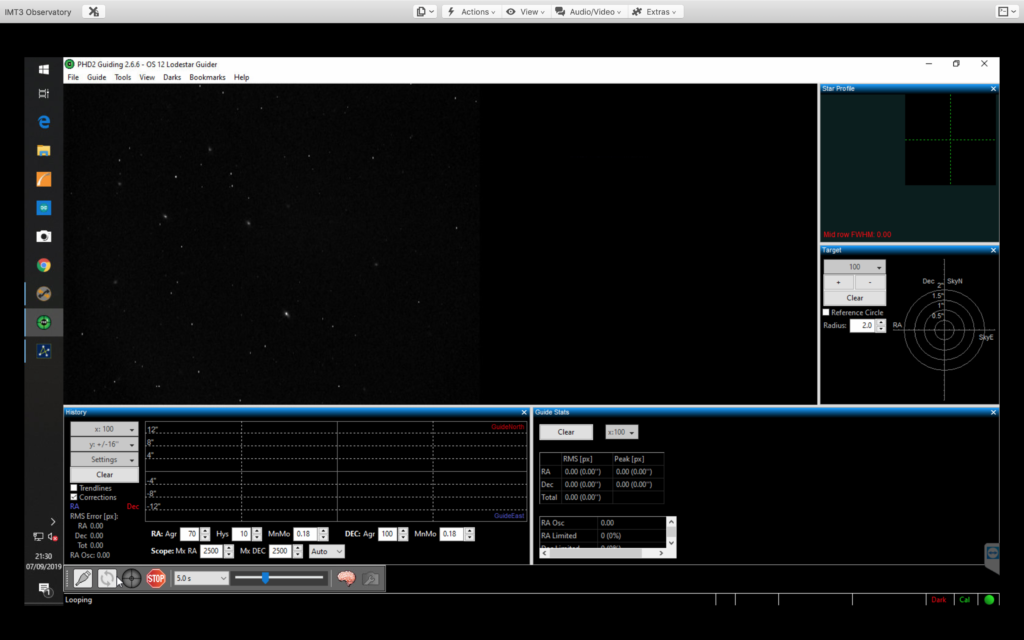
The resulting guider graph was smooth, too smooth, and the resulting 5 min image was trailed! Ok so something else not right, so after taking a look it turned out I had selected a hot pixel to guide on, so I exposed a little longer from 5s to 10s and selected what looked more like a star and this time tried to guide. The guiding went off the chart which proved this was a star and that I needed to calibrate the guider (seemingly every night I go out, I will need to see if that is right). So off I went to calibrate the guider.

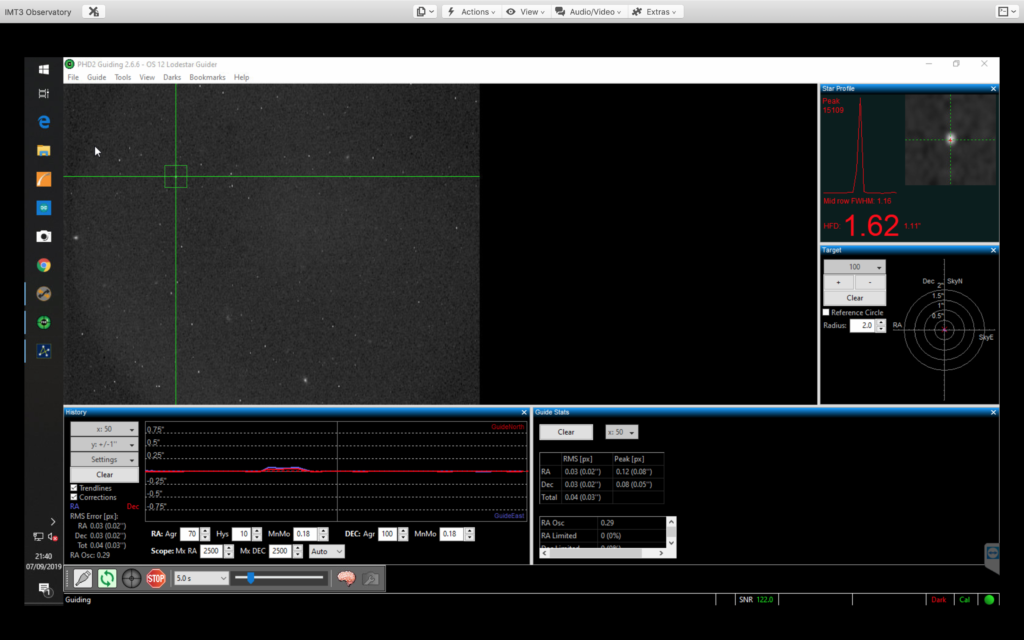

In calibrating I realised the Darks were going to be needed, the first calibration run failed. I then went out to cover the scope using my trusty chair to help with the lift I needed to reach the end of the 12″ as it was point upwards. I then went back inside and took a set of darks ( I thought I had done this before), anyway with a new dark library in hand I recalibrated the guider.
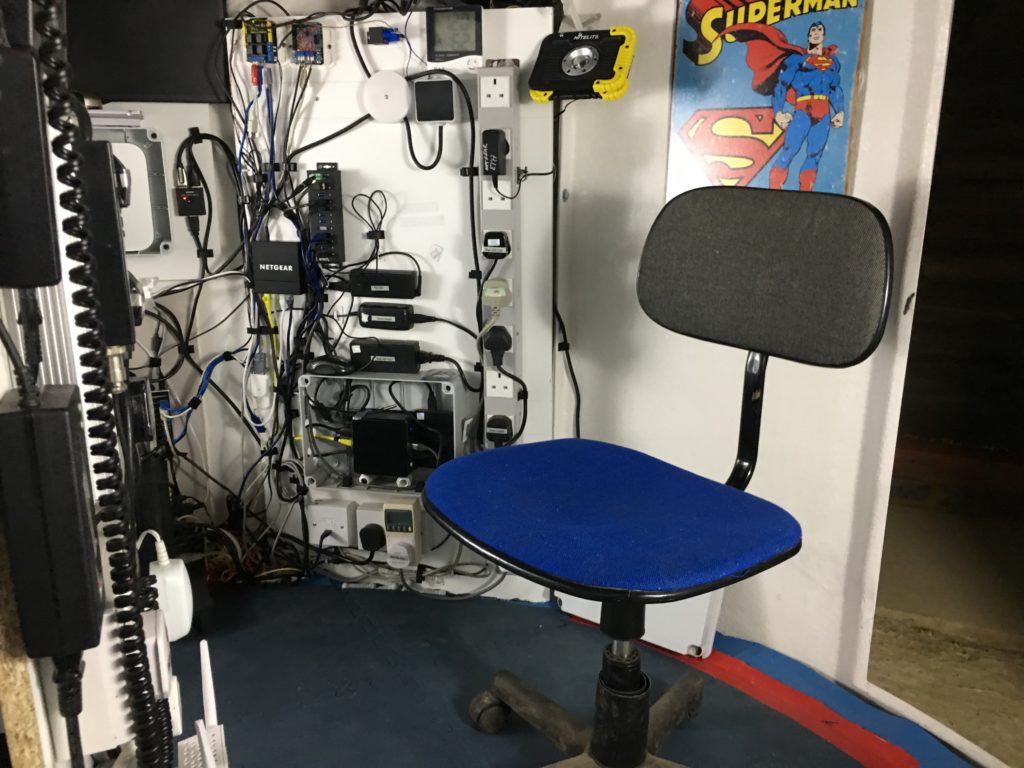
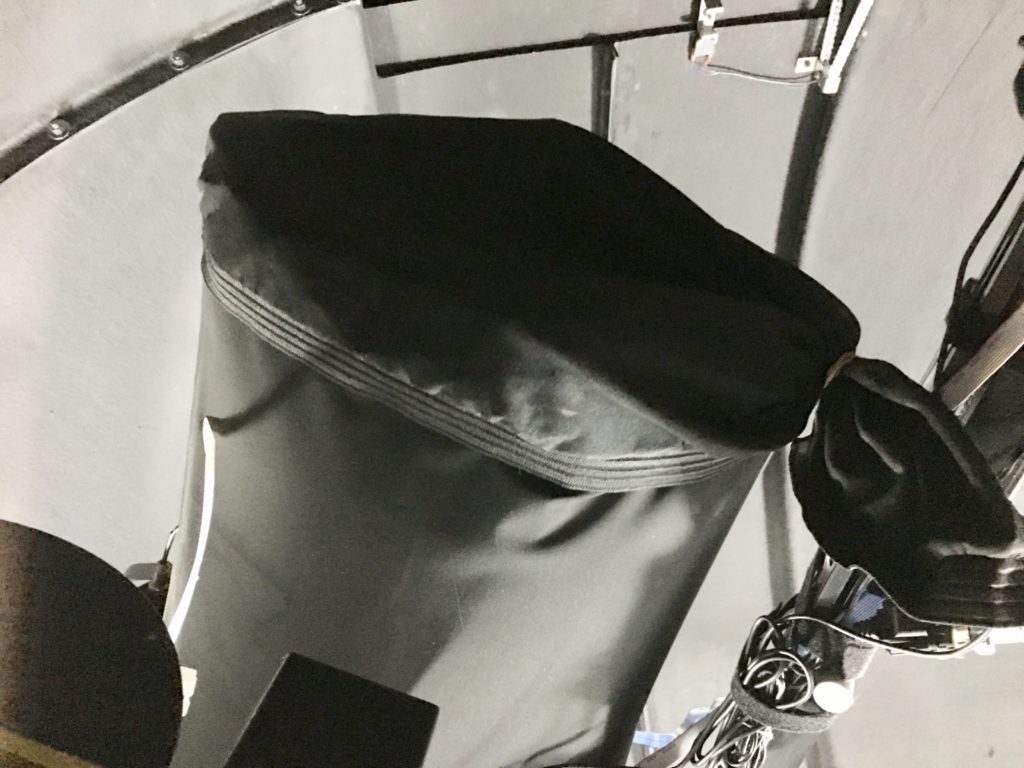
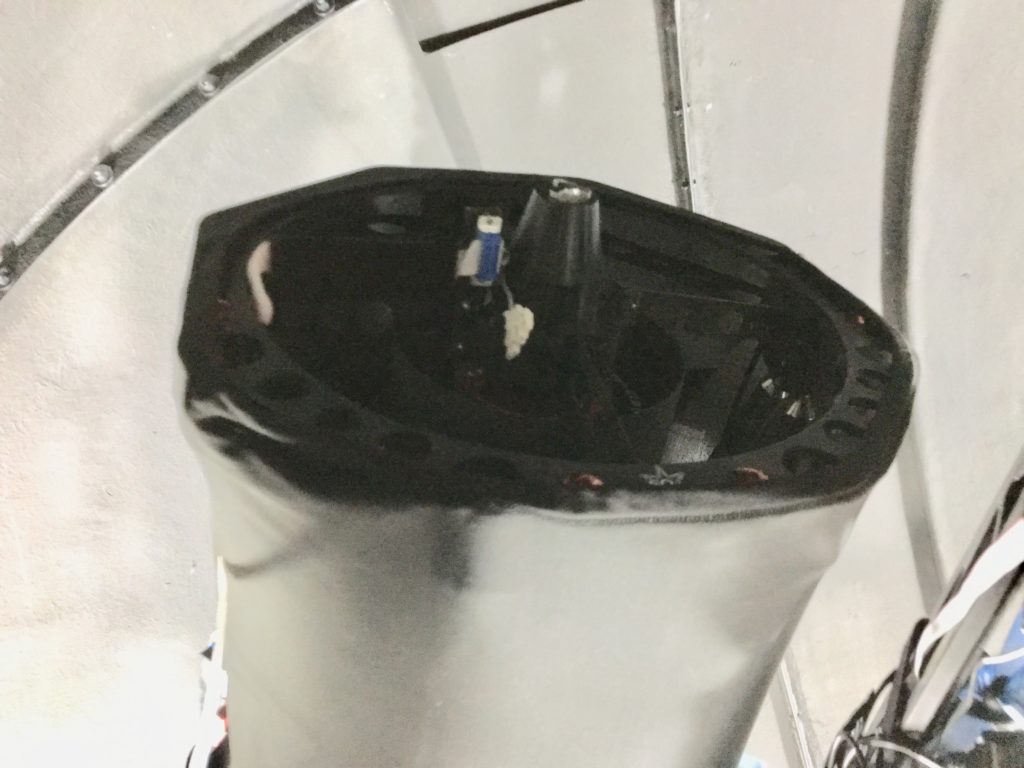
Now suffice to say the problems did not stop there, I had guider calibration failed, star did not move enough and after 4 attempts I managed to calibrate the guider and the guiding then started at last! the main thing was to change the number of steps required to 6 and the pulse time changed then to 1500ms from 200ms. This was enough to resolve the problem.
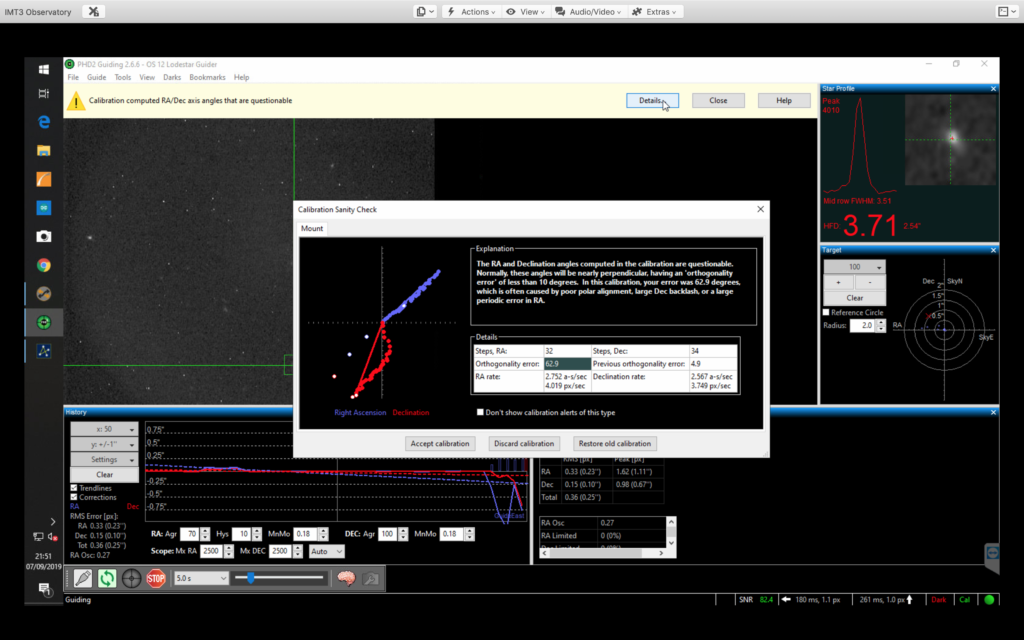
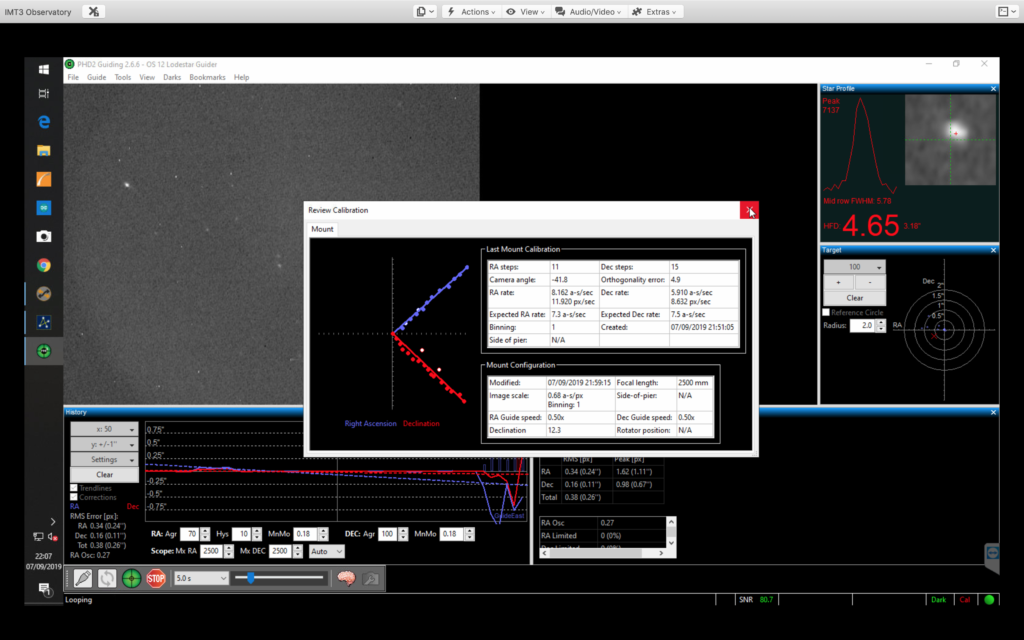
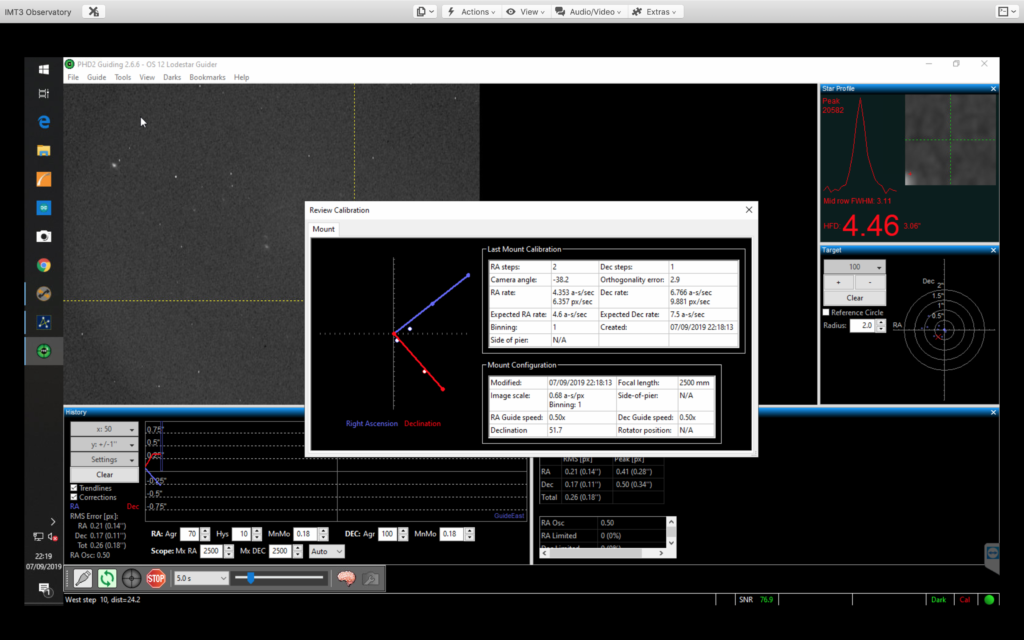
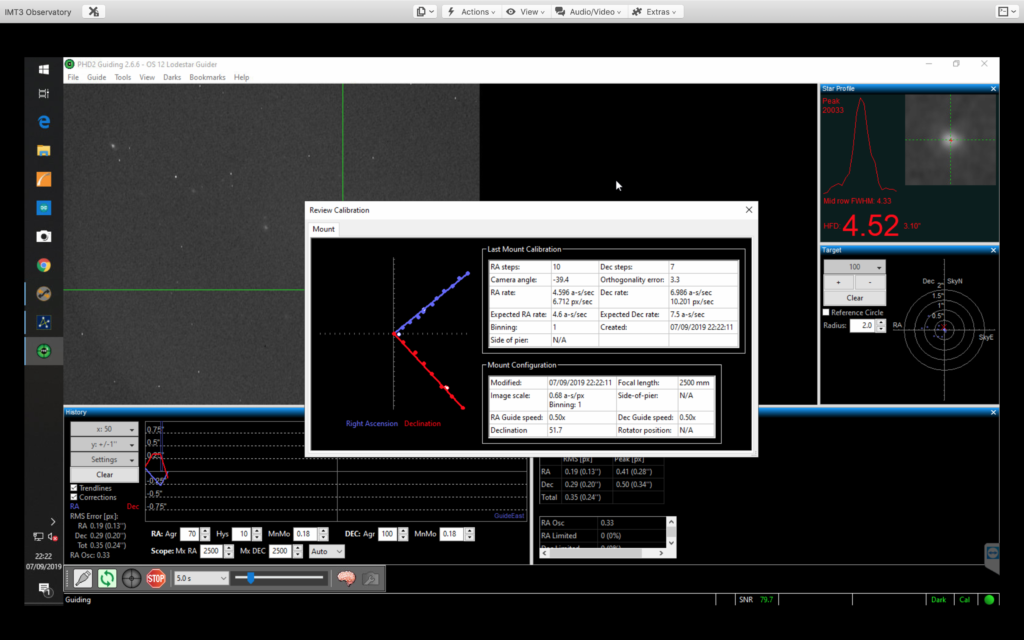
For completeness here are the settings I am now using that work in PHD2
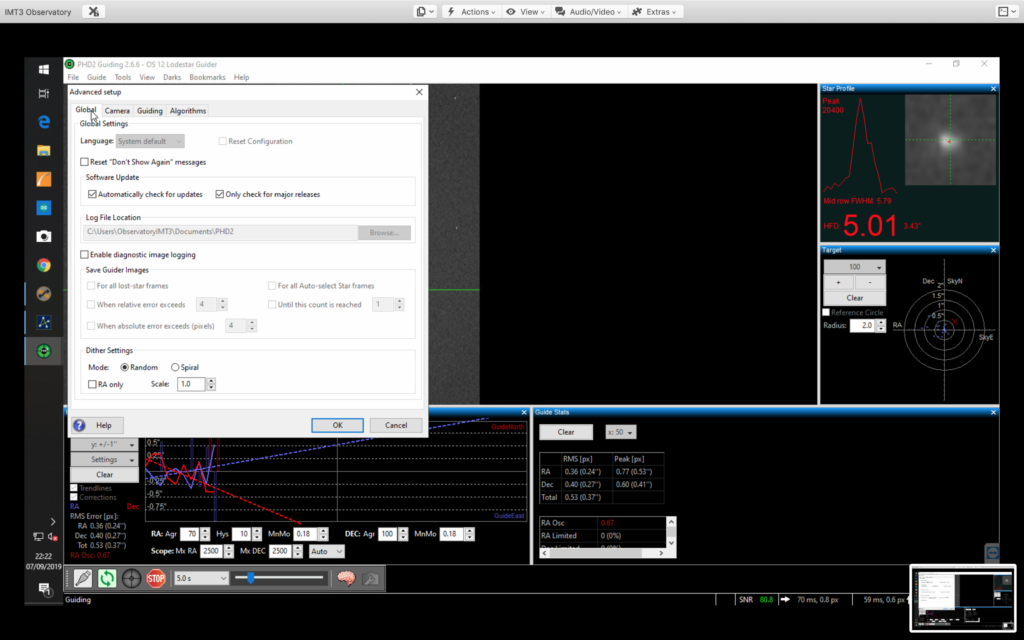
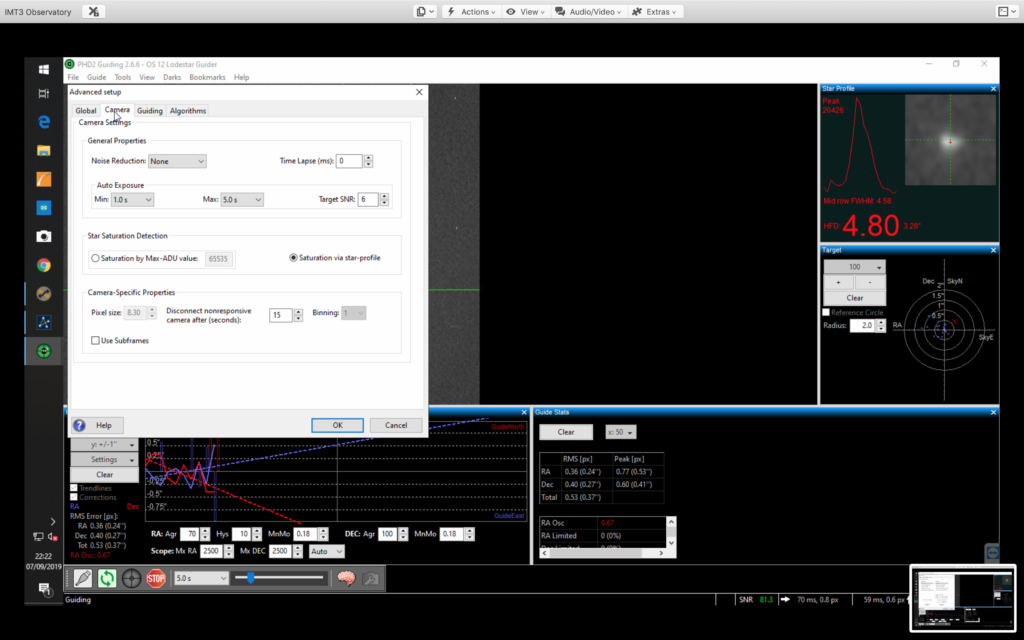

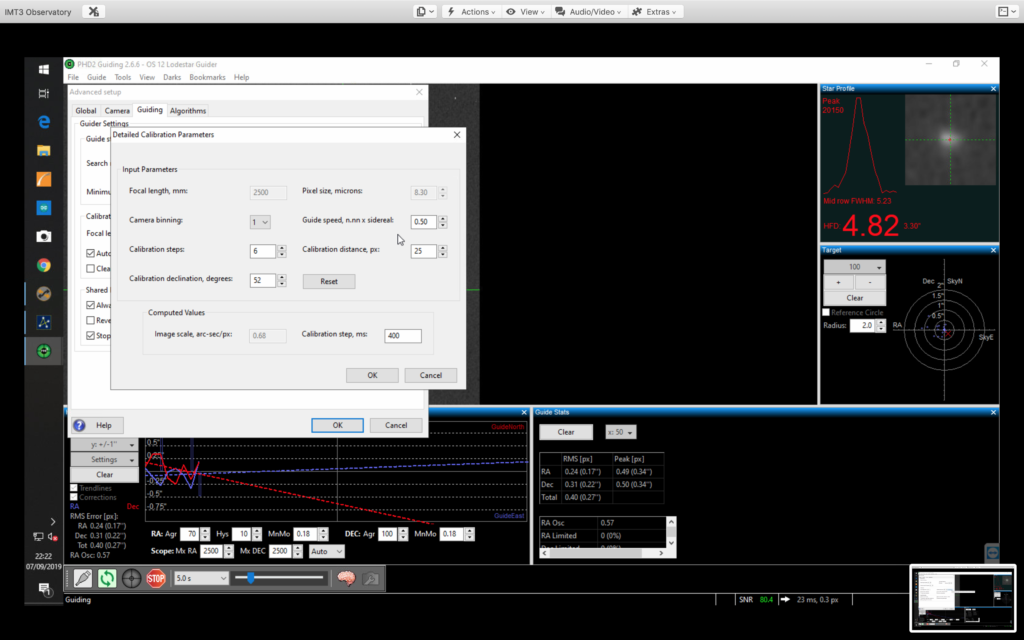
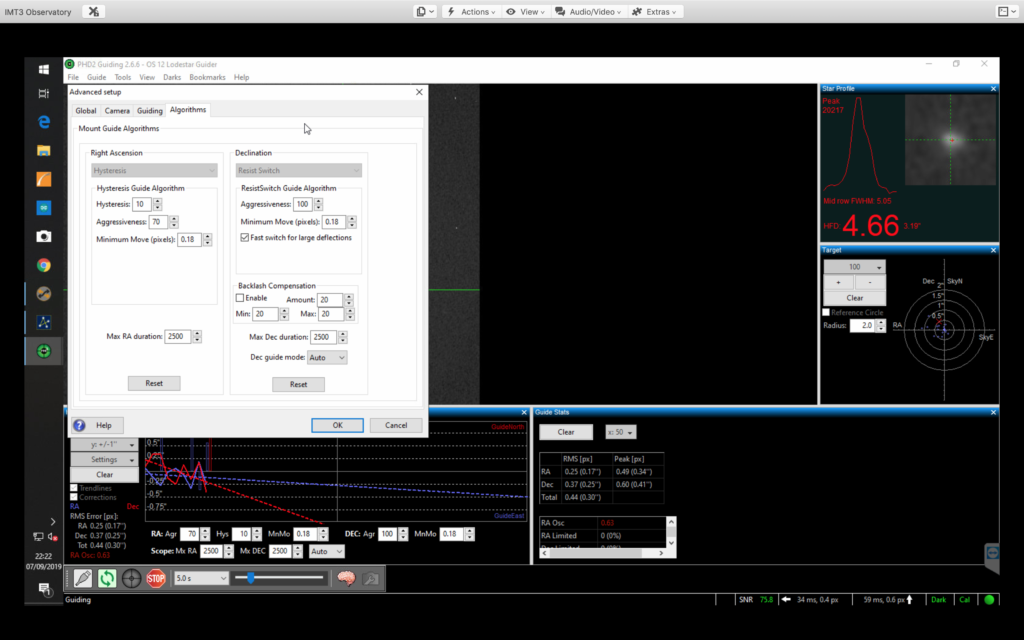
So after much time spent and it now being precisely 22:33 I realigned M76 in the centre as it had moved with all the calibration challenges (remembering to change the filter to Luminance during the Closed Loop Slew in TSX and then back to OIII to start my imaging run.
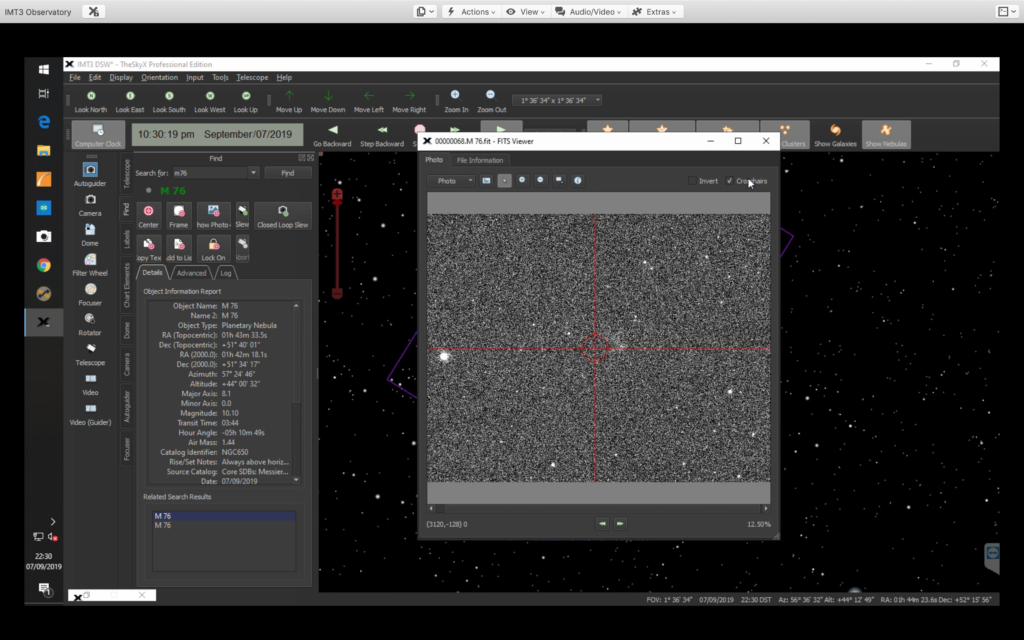
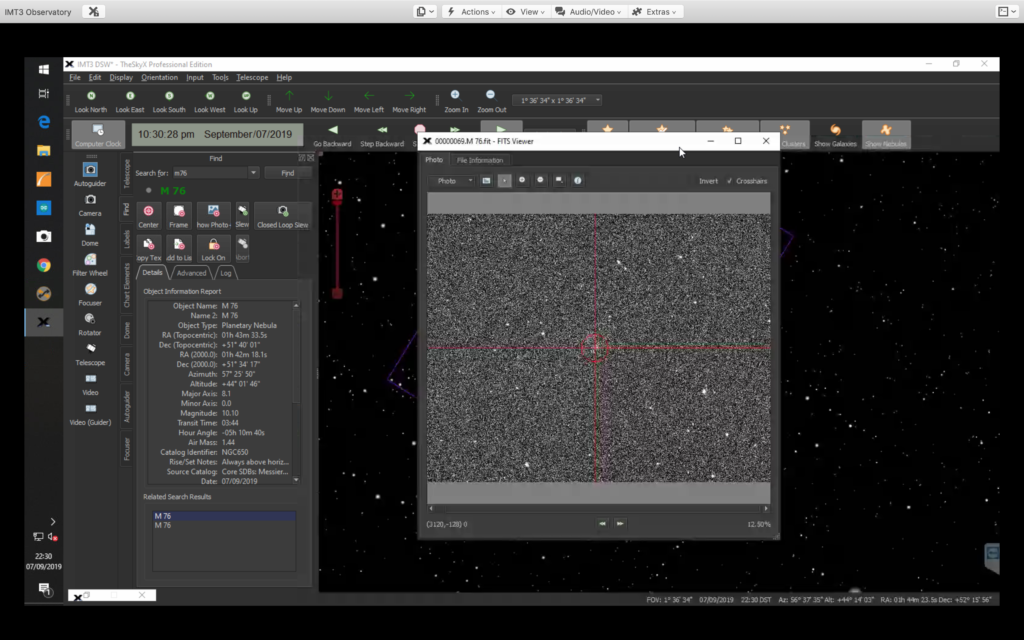
I tested at 2 minutes first, then 5 minutes, then 20 minutes before starting the final run to decide on the subs I would use. By 23:14 I had the 20 minutes sub and settled on 20 minute subs for the rest of the night.
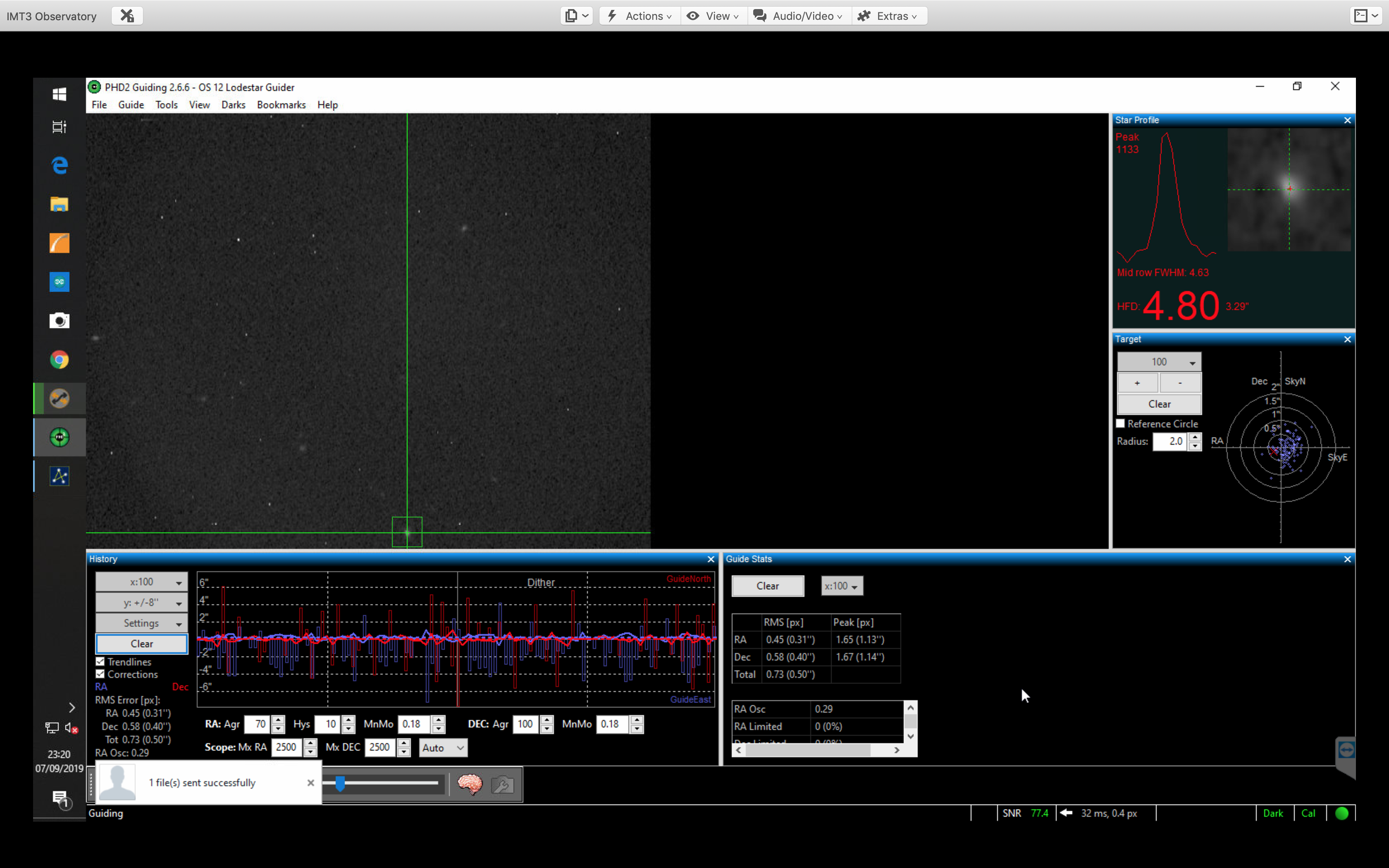

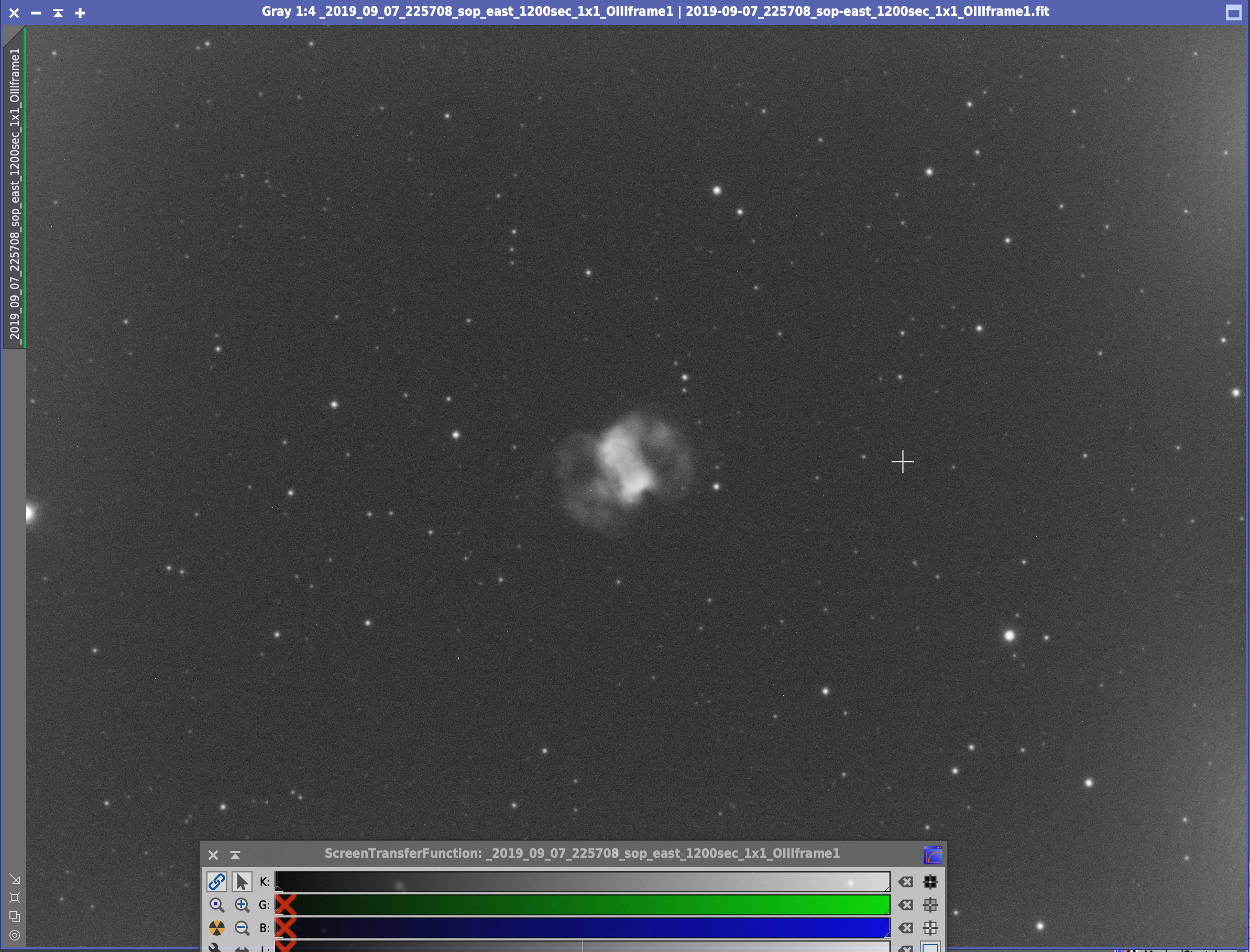
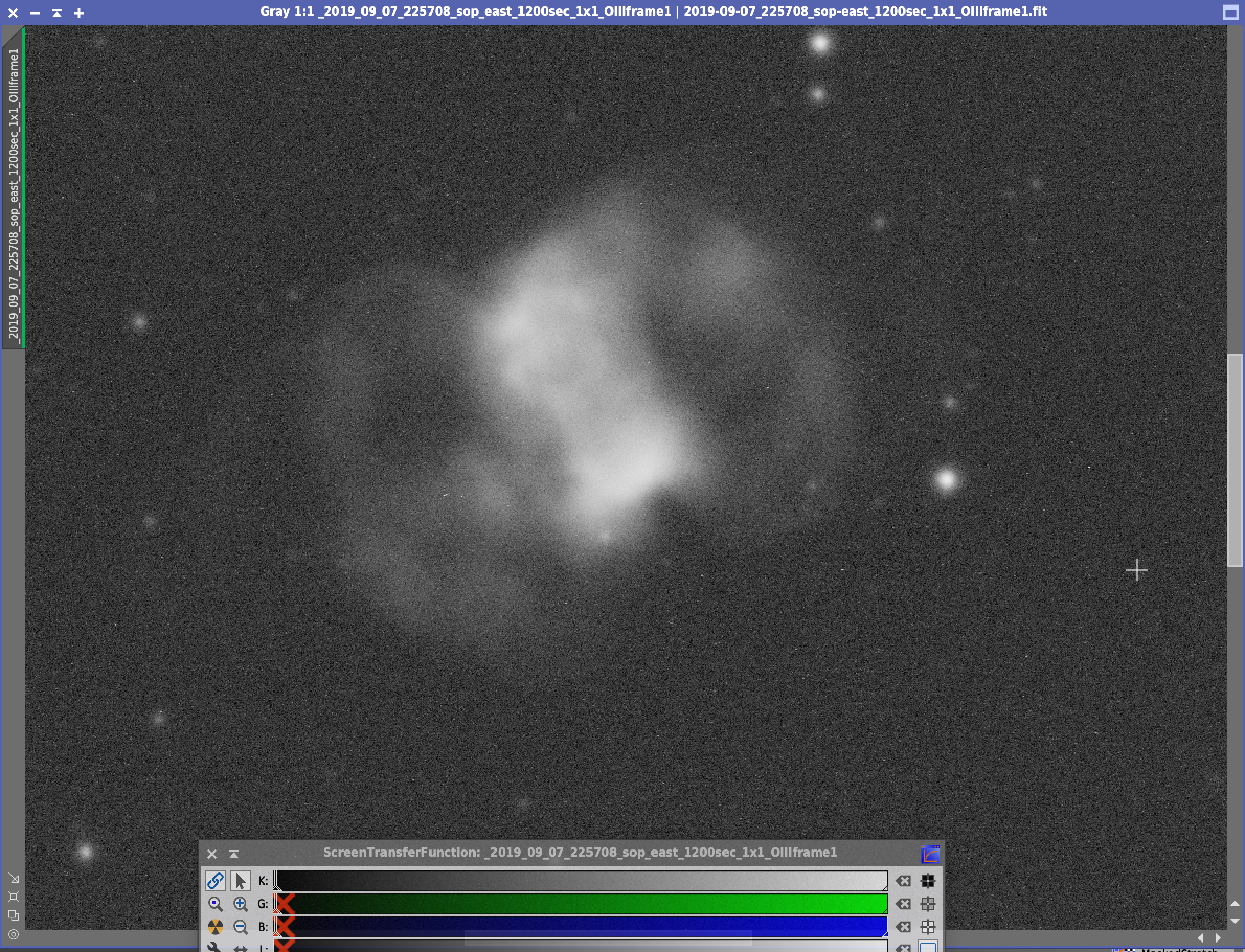
Meanwhile the Summer Triangle of Deneb, Vega and Altair could be seen through the ASC and I noted that the star Tarazed in Aquila next to Altair at magnitude +2.7 could be seen also.
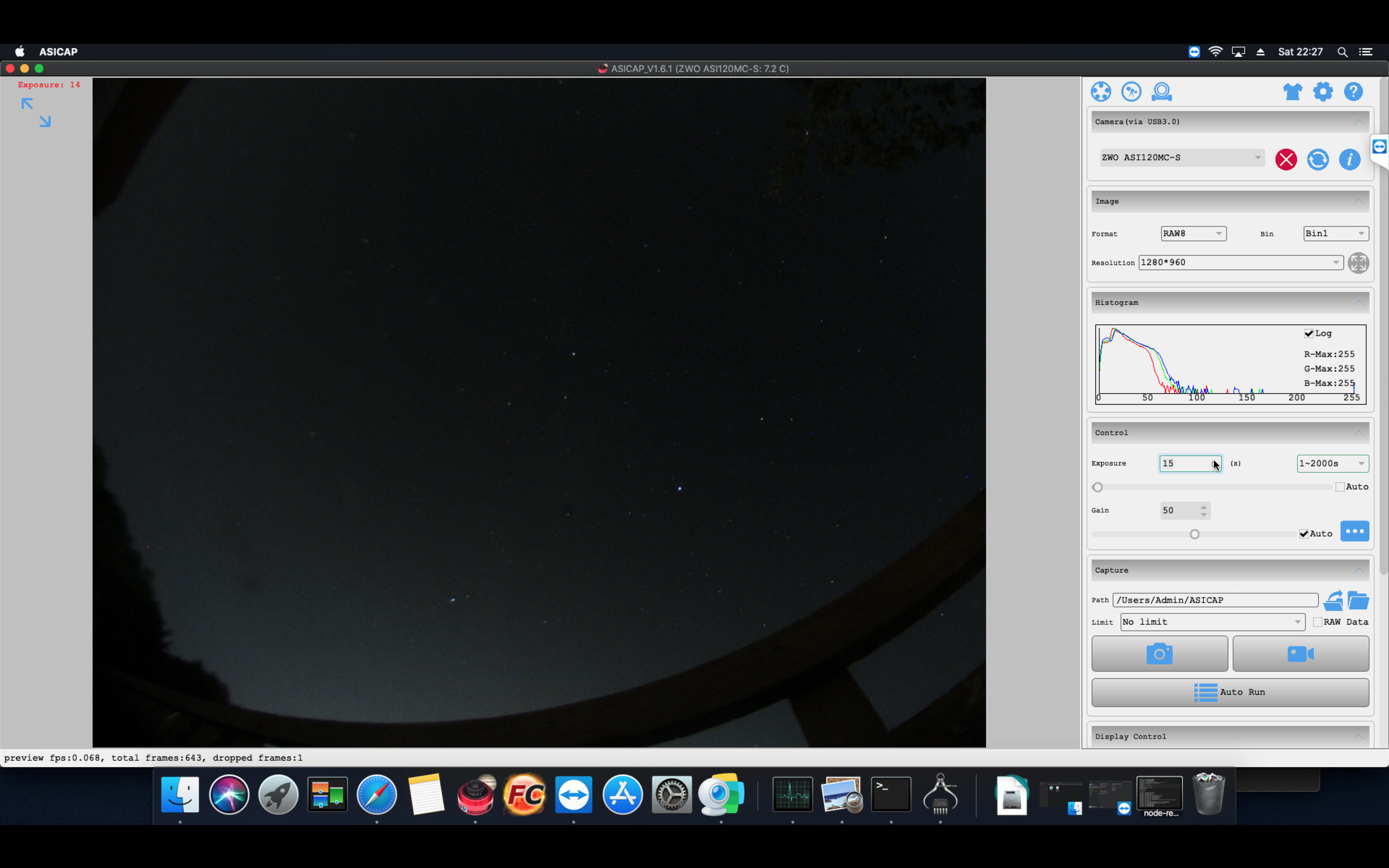
I noticed the trellis lit up and had a quick word with my daughter to close the blind in the bathroom 🙁
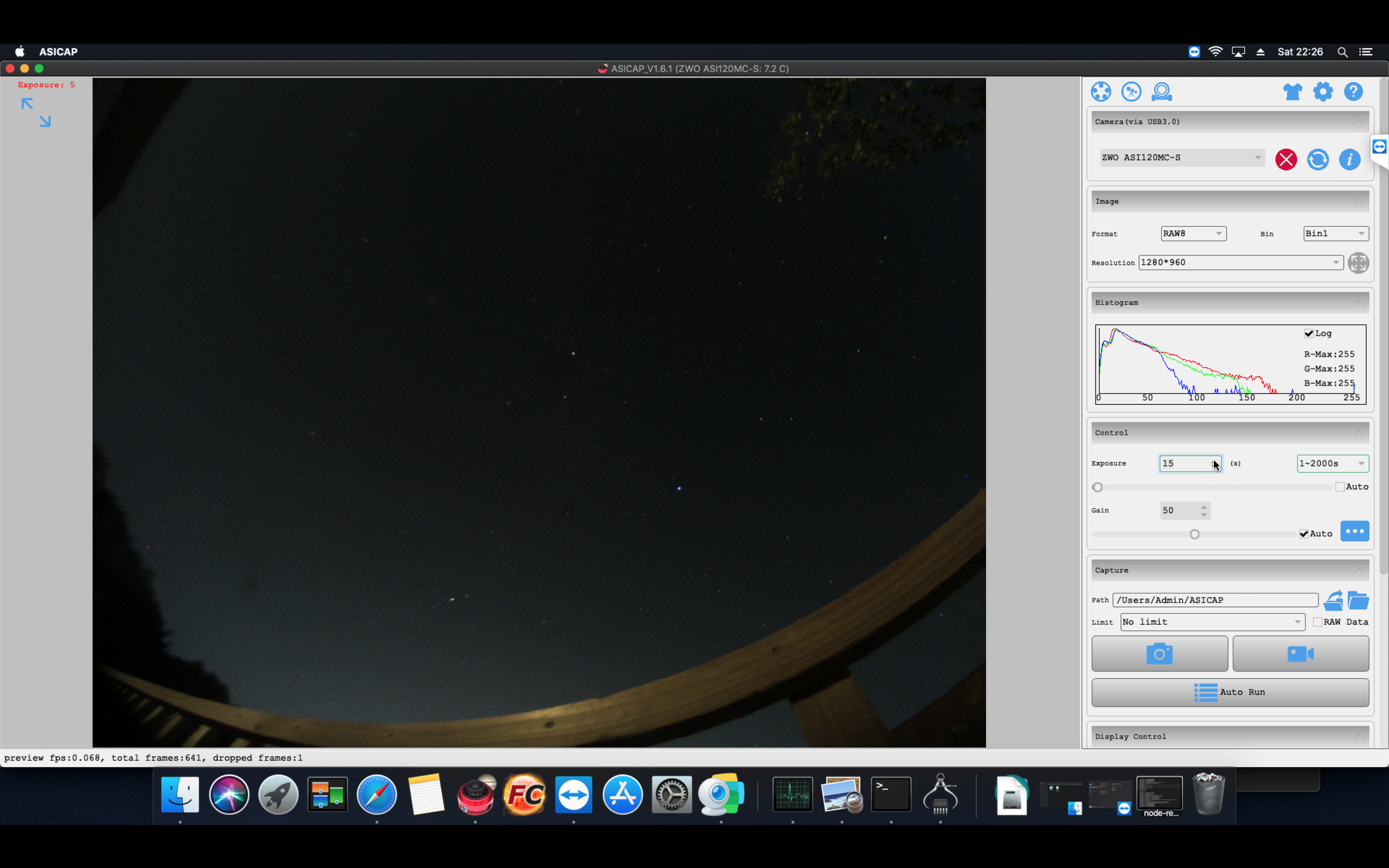
Here is the temperature and pressure information from the dome internal sensors at around midnight.

At 03:49 I decided to do a quick autofocus to see if the focus had changed during the night and given the temperature outside was now around 5℃. I paused the current sequence which gave me the option of cancelling or pausing at the end of the current image. I then ran autofocus but no stars were found. I went into the setting for autofocus within SGPro and changed the exposure time for the OIII filter from 1 to 20 seconds. This allowed the autofocus to see stars but the auto focus would not complete successfully and just kept creeping out. So instead I gave up, especially since astronomical darkness was finishing soon. Instead I slewed to my Flat position at Az 359, 21′ and Alt 00, 00′ to take the flats.

I went out to the dome to manually turn on the light sheet which we need to automate and then turned it off after I took 10 flats through the OIII filter at 10 seconds each to get a good illumination. It would be 0.5 seconds through Luminance filter. I then packed up set the darks running and went to bed.
